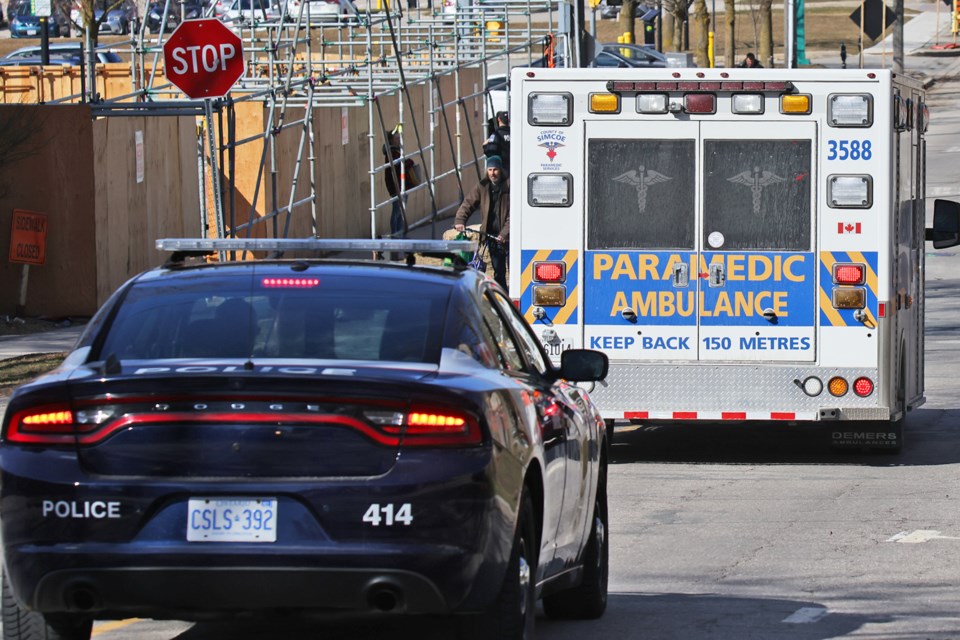The way local paramedics respond to calls will be changing this fall.
Beginning Nov. 13, Simcoe County Paramedic Services will be rolling out its new Medical Priority Dispatch System (MPDS), a software program described as an industry standard for triaging patients. It is expected to "optimize" the deployment of paramedics, hasten response times and make for better "patient experience and outcomes," according to a report presented to county councillors at Tuesday's committee of the whole meeting.
It's anticipated that all ambulance dispatch centres in Ontario will transition to the new system by the end of 2027, noted Jane Sinclair, the county’s general manager of health and emergency services.
“As you know, there are more and more requests for paramedic services. In 2023, we had an increase of 20,000 calls and this year we are anticipating a 6.3 per cent increase over and above that … exceeding 96,000 calls," she said. "That increase in call demand is continuing."
The province's new dispatch system will be a more “sophisticated tool” to help all paramedic services across the province prioritize the most life-threatening, time-sensitive calls, said Sinclair.
“We anticipate a dramatic decrease in the number of life-threatening — or lights and sirens calls. Currently, our highest priority calls are about 70 per cent of those 90,000 calls, (meaning) about 69,000 are lights and sirens calls," she added. "We anticipate, with the rollout of this new dispatch program, it will reduce to 40 per cent, which is a very dramatic decrease and will equate to about 32,000 calls (and) almost cutting those lights and sirens calls in half.”
That decrease will also impact tiered response for all municipalities, Sinclair noted.
“We are very excited about the new software program. We know it’s much better and will get us to the right calls,” she said.

MPDS is an international standard, established in 1977. It's being used in more than 3,500 call centres worldwide in more than 50 countries.
Its implementation in Ontario is being overseen by a medical director and physician, said Sinclair, noting it’s already in place in eight different regions.
Patrick Hervieux, the county's deputy chief of paramedic services, said the new system will provide a more accurate prioritization of calls. With the system currently in use, it can't always differentiate the type of calls.
“For example, chest pain in a nine-year-old child who has fallen and chest pain in an 80-year-old man who has co-morbidities are treated as the same in the system,” he said. “The beauty about MPDS is that it drills down to a better medical specification about what the actual emergency is.”
That information is then classified into five levels, which are colour indexed, and gives the paramedic service the ability to prioritize 911 calls.
The big change, Hervieux explained, is going from high to low acuity, which refers to the severity of a patient's illness or medical conditions.
“That’s the scale —emergencies will always be prioritized through that specificity," he said. "The biggest thing is it ensures when there is a true emergency, there will be an ambulance resource available. This will allow us to deploy the right resources at the right time.
"MPDS is an exponential growth for us to be able to use our resources accordingly," Hervieux added. "In our current state, we don’t have that ability. On Nov. 13 we will turn that switch on and will be able to reprioritize calls and say, with specificity, we want this resource to go to this call and not go to a lower priority call.”
That change is expected to result in a decrease in Code 4 calls (potentially life-threatening) of approximately 37 per cent, which he acknowledged is a “great thing."
“Oftentimes, we’re driving around the community (with) lights and sirens through intersections and in bad weather, and this has inherent risk," Hervieux said.
"We will always do that when the emergency requires it," he added, "however the rate we were doing that in the past … is actually a little bit flawed and could add to some danger in the community, so we are really happy to see that change. The really big change is the triaging and knowing what resource to send at what time.”
The improvement in resource management is something the paramedic service has struggled with, Hervieux acknowledged.
“We know from the calls that a higher call priority requires a higher response and faster," he said. "We never had that ability because they were triaged the same.
"You could be going to a severe nosebleed and a child unconscious would come in and they would not prioritize them. They were treated the same. Now we will have the ability to redirect at all times," Hervieux added.
This will be accomplished by dispatchers asking callers “very specific" questions during the intake call, which will then allow the situation to be triaged accordingly and the appropriate resources being sent.
“The high-acuity calls will always be serviced immediately," he said. "There will be no delays to any emergency in the community at any time. The low-acuity calls may be serviced from an ambulance travelling from a greater distance and that could cause a slight delay, but that’s medically OK and has been validated through data through science.
“If you have a broken leg, it’s painful and we understand that, but if someone is having a heart attack, they are the higher priority. It’s just giving us a little bit of flexibility to use the right resources in the right place.”



